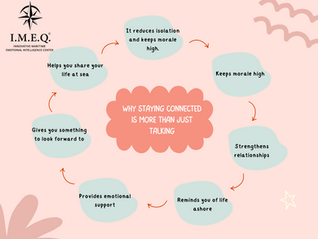Stress onboard
- IMEQ CENTER HR dpt
- Mar 26, 2018
- 4 min read
Updated: May 31, 2021
HOW TO DEAL WITH STRESS ONBOARD
Is Stress Getting to You?
Stress and anxiety are prevalent and enduring aspects of everyday life. We all encounter and deal with stressful events in our personal, professional or social life. It is important to remember that not all stress is negative, eustress is positive stress, since it motivates us to produce and maximize our output and creativity, in contrast distress is negative stress, and it is evident when a person perceives himself as lacking the ability or the resources to control a stressful situation ( Selye, 1976).
Unequivocally, seafaring is a strenuous occupation and seafarers are exposed to an increased number of work related stressors : fatigue, long working hours, job monotony, noise, vibration, temperature changes, a multinational environment, limited recreation activity, isolation , long separation periods away from home …. Factors that may produce an imbalance between work demands and personal resources leading to a decline in physical and psychological health and an increased risk for accidents and injuries. ( Carotenuto, et. al., 2012).
Stress is defined as a negative emotional experience accompanied by physiological, cognitive and behavioral changes and responses aimed to reduce or change the stressful event or effects of it ( Baum, 1990). How well we cope with stress is mediated via our appraisal of the stressor , and the resources available to deal effectively with the stressor.
Most seafarers are suffer from moderate to high stress that can lead to a vicious cycle of unhealthy behaviors that can be difficult to escape from : sleeping disturbances, unhealthy eating, weight gain causing mental and physical ailments.
Physical symptoms of stress include irritability , anger, fatigue, lack of interest or motivation, nervousness, anxiety, sadness, muscular tension, headaches, indigestion, stomach problems, appetite changes, faintness, dizziness, erectile dysfunction, change in sex drive, teeth grinding .
Tips for dealing with stress onboard:
Develop Resources:
1.Identify your strengths, capacities, skills that strengthen your confidence. Think of a survival resource that helped you cope with a stressful experience in the past.
2. Assess, recognize and develop your creative resources: talents, skills or competencies, traits etc.
What is your creative resource? Optimism ? humor ? flexibility?
3. Evaluate your resources are they external or internal? Internal resources refer to personality traits such as humor, optimism, courage, flexibility , spiritual connections, accountability etc. External resources can be hobbies, activities, team or religious associations, social support, teams etc
4. Use cognitive re-appraisal when evaluating a negative event notice the negative thinking that is causing you the emotional tension . It is mostly how we interpret events that evoke strong negative emotions.
5. Engage and interact with other onboard - do not isolate yourself— become interested in learning about your team mates.
6. Establish an open communication channel with someone you trust and openly discuss possible difficulties or concerns you have.
7. Do not let negative emotions hijack you. When something bothers you address it immediately don’t turn it into rage, sadness and resentment.
8. Keep your expectations realistic.
9. Be accountable for your actions.
10. Develop a healthy lifestyle onboard : a. eat healthy and balanced meals b. maintain a sleep – rest schedule c. exercise regularly 4. develop pastime activities games, puzzles, reading time
11. Keep a diary write your thoughts and feelings.
12. Practice mindfulness and relaxation techniques.
Adverse experiences can interfere with our ability to remain “present” we may find ourselves focusing on negative events, painful memories or anticipate that the future will bring more problems and distress. When we find ourselves dwelling on the past or in painful and negative memories, we are depriving ourselves of the necessary resources to deal with the present. Mindfulness can help us discover the resources we need to cope with stressful events in the present.
THE 5 BUILDING BLOCKS OF PRESENT MOMENT EXPERIENCE include:
Our thoughts, meanings and beliefs we hold about ourselves, others and the world.
Our emotions , our mood and our feelings,.
Our five senses, perceptions : taste, touch, image, sound and smell perceptions,
Our movements including our facial expression, gestures and posture and
Our bodily sensations . the vibrations or the tingling of the body sensations
Practicing a Positive Experience- the Good Moment
Think of a good moment when you felt untroubled. The moment can be as simple as eating dinner with a loved one, or reading a good book, or watching a movie etc.
On a piece of paper briefly describe your good moment
Take a few long breaths and let your self sink into the good moment, describe each of the 5 Building Blocks of your good moment
5 BUILDING BLOCKS OF THE GOOD MOMENT
Your Thoughts during the good moment
Your Emotions during the good moment
Your Five Sense Perceptions ( images, sounds , smells, taste, touch)
Your Movements
Body Sensations
Notice which Building Block best helped you connect with the positive feelings of this good moment? Which one could you focus on to help you feel again this good feeling?
Building on positive and good moments of our experiences can alleviate or ease the burden of stressful and difficult moments at present.
Research has shown that practicing mindful mediation on a daily basis reducesstress and stress related symptoms.





































































































Comments